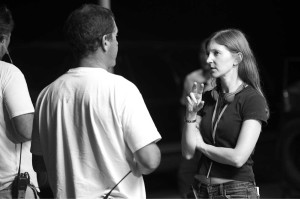
The screenplay took a long time to develop. Meyers had wanted to tell the story of a mother torn between work and family for a while, but had been unable to get a handle on how to tell that narrative, so she put the script aside. In the interim, she was hired by WILL Interactive to do an army training film at Fort Bliss.
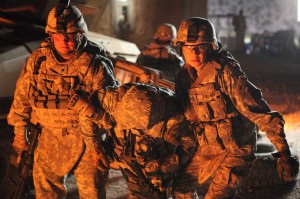
Since Meyers did not have a military background and needed to understand the problems she was going to be addressing, as well as what duties members of the military actually performed, she embarked on extensive research. During a focus group, Meyers was interviewing a group of infantry soldiers and heard a side of the war she had not previously considered. A single father revealed that, because the mother of his child was out of the picture, he had to leave his son with neighbors during his two deployments to Iraq.
“I felt like I hadn’t seen a movie about a soldier who was also a parent, certainly not a female soldier who is also a mom and trying to balance these two competing obligations,” explained Meyers. With this new insight, she had also found a way to tell the working mother story that she had been wrestling with for years. “I found a way to tell it that was relevant and hopefully truthful,” she said. “That was the genesis of Fort Bliss.”
Her collaboration with producer and cinematographer, Adam Silver, began working on that first army training film. He thought the script for the training film was really good, and encouraged her to write the feature, becoming her creative sounding board early in the process as she developed the story and wrote early drafts.
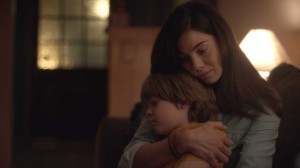 “We both brought a particular understanding of the subject matter to this story. He really was the perfect partner for the project. When it came time to actually realizing the vision and shooting the film, we were aligned as to how it was going to look and what we wanted to achieve,” Meyers explained. “We wanted it to be grounded in naturalism. We used the phrase ‘the beauty of naturalism.’ We did want certain elements to be expressive, but not overly stylized.”
“We both brought a particular understanding of the subject matter to this story. He really was the perfect partner for the project. When it came time to actually realizing the vision and shooting the film, we were aligned as to how it was going to look and what we wanted to achieve,” Meyers explained. “We wanted it to be grounded in naturalism. We used the phrase ‘the beauty of naturalism.’ We did want certain elements to be expressive, but not overly stylized.”
To achieve the vision for the film, Meyers and Silver worked with a detailed look book. They also viewed war films and pulled photojournalism references to come up with a visual style that Meyers described as Kramer vs. Kramer meets The Hurt Locker.
Because the film is about two worlds – military and civilian – colliding, each world looks and feels different. The palette of the film shifts between the warm and vibrant colors that project a sense of camaraderie when the soldier returns home from her deployment to flatter, cooler tones, fluorescent lights and a darker mood that portrays her disconnect in the civilian scenes. The height of the contrast between the two worlds is most apparent during a scene that cuts back and forth between Maggie remembering incidents in Afghanistan while she works out her frustrations with civilian life by doing vigorous push-ups. Eventually the atmosphere warms up as the story progresses.
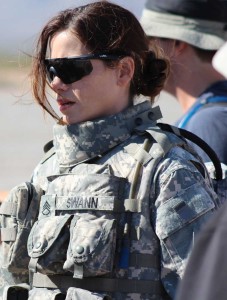 The filmmakers wanted an unobtrusive handheld style so that they could allow the actors performance freedom. The camera was prepared to follow the action, giving the shooting style a type of fluidity. “We wanted to get out of the way of the actors. We did not lay marks down,” Meyers explained. “We never had to compose shots for light. It was always about what was organic to the scene and the motivation of the characters.”
The filmmakers wanted an unobtrusive handheld style so that they could allow the actors performance freedom. The camera was prepared to follow the action, giving the shooting style a type of fluidity. “We wanted to get out of the way of the actors. We did not lay marks down,” Meyers explained. “We never had to compose shots for light. It was always about what was organic to the scene and the motivation of the characters.”
The homecoming scene is a great example of Meyers’ organic way of working with talent. Because the film was a low-budget indie and the filmmakers did not have money for hundreds of extras, they put out a casting call for volunteers and the El Paso community responded whole heartedly. “A hundred people came. They came with their kids. Whole families came. Soldiers came. Spouses. We had a three-week-old baby. That was the special spirit of the movie,” revealed Meyers. “With that many people showing up we decided to shoot it like a documentary. We gave the extras very simple instructions and then the camera just captured it as if it was unfolding in real life. And a lot of these people had been through the experience. We basically paired a family with each soldier and let the scene play out.”
The script did not change in the editing, but was enhanced by the talents of editors Matt Chesse and Carsten Kupanek. The use of flashbacks was written into the screenplay, but in a fairly simple way. The editors used sound effects and dialog to seamlessly draw the viewer into the past events. They executed the flashbacks by breaking them up, starting with shorter cuts and then extending them into longer segments as they revealed more backstory information.
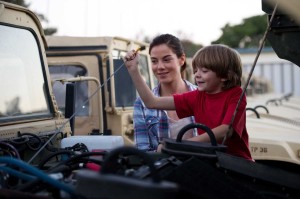 Meyers acknowledged, “The way they were executed in the film – you kind of dip your toe into the flashback and then come out of it, and then you go back for a longer period and then come out it, and you get the sense that she is kind of fighting the memory – that was entirely to the credit of our editors, Matt and Carsten. That elegance with which we are drawn into her memories, that’s purely the craft of the editors. That dance between the two worlds was fully realized in the edit. It is something they did from the get-go. They had such great instincts. We never revisited that. It was so well executed.”
Meyers acknowledged, “The way they were executed in the film – you kind of dip your toe into the flashback and then come out of it, and then you go back for a longer period and then come out it, and you get the sense that she is kind of fighting the memory – that was entirely to the credit of our editors, Matt and Carsten. That elegance with which we are drawn into her memories, that’s purely the craft of the editors. That dance between the two worlds was fully realized in the edit. It is something they did from the get-go. They had such great instincts. We never revisited that. It was so well executed.”
Although Meyers had never worked with either editor before, Kupanek had assisted Chesse on World War Z, so they had a symbiotic working relationship. The editors brought out the best in the sequences, were very smart with how to enter and exit scenes, and paced the film beautifully. According to Meyers the editing “draws me in every time I see it.”
Every element of the production was carefully planned to support the naturalistic approach to the film and support the characters and story. “Krystyna Loboda, our production designer and Scott Enge, our art director, were so resourceful and so creative. I feel like they just made everything look like it belonged,” said Meyers. Working with the limited budget, they created the illusion of an extra room in the apartment, built the office, redressed locations, and found ways to use small details such as the pencil bed and the beat-up refrigerator to reinforce character and “make the story feel more specific.” All the while they used the color palette and texture to set the mood while changing the environment to match Maggie’s evolution.
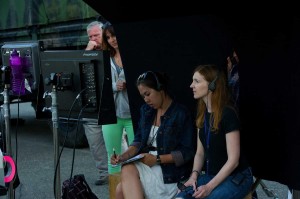 Costume designer Jessica Wenger created designs for each of the characters “that did not feel like costumes,” but were carefully chosen for each character. They played with a Texan flavor, hinting at elements of the environment, but without going too far. Alma (Emmanuelle Chriqui), who stands out for her warmth and nurturing qualities is always dressed in something floral and vibrant. When not in uniform, Maggie is very no-nonsense, generally dressed in jeans and t-shirts. “You can just take a still frame of any scene with the two of them and you know what the difference is between these characters. That’s a great tribute to the costume design,” said Meyers.
Costume designer Jessica Wenger created designs for each of the characters “that did not feel like costumes,” but were carefully chosen for each character. They played with a Texan flavor, hinting at elements of the environment, but without going too far. Alma (Emmanuelle Chriqui), who stands out for her warmth and nurturing qualities is always dressed in something floral and vibrant. When not in uniform, Maggie is very no-nonsense, generally dressed in jeans and t-shirts. “You can just take a still frame of any scene with the two of them and you know what the difference is between these characters. That’s a great tribute to the costume design,” said Meyers.
Sound design played a key role in the film. One of the big challenges was an element that the filmmakers referred to as “Maggie’s combat mode,” where, at several key moments in the film, the sound of the world goes away. “It had to feel different. It had to look different. And it had to sound different because it was about this heightened state where you kind of shut out the world in order to take action in a stressful situation,” explained Meyers. “So the question is how do you put that on screen?”
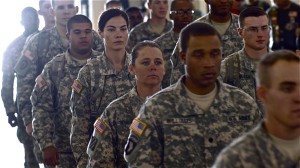 Sound designers, Greg and Darren King, were instrumental in helping the filmmakers find the right aural representation for telling that “combat mode” part of the story. They played a lot in the editing with how to create the sense of being in Maggie’s head, and how stylized it would be.
Sound designers, Greg and Darren King, were instrumental in helping the filmmakers find the right aural representation for telling that “combat mode” part of the story. They played a lot in the editing with how to create the sense of being in Maggie’s head, and how stylized it would be.
According to Meyers, the opening combat scene came out “beyond my wildest dreams.” Silver and camera operator Mikey Jechort shot the scene extremely well, and she was very happy with the edit, but the scene was brought to life with the sound design. “The whole film was elevated by their work,” she proclaimed. “That was really exciting. These people are masters with what they do.”
Composers, Asche & Spencer, found the perfect balance in the score to add emotional depth without being a distraction. “I find their music haunting and beautiful,” said Meyers. “They make really interesting choices in instrumentation. For instance, when you see flashbacks, there is this Middle Eastern flavor to the music, but it is not a Middle Eastern piece of music per se, it’s just the instrumentation. Things like that, that I think are relatively subtle, but help further the narrative.”
The film had a 21 day shooting schedule. Production was completed in the fall of 2012. The post schedule was a bit more drawn out because the production was at the mercy of other people’s schedules, sometimes stopping for a period of weeks or months, so it took about a year to finish. As a low-budget independent film, Meyers admitted, “The truth is, we had to ask for a lot of favors. We had to be flexible. That was part of the deal.”
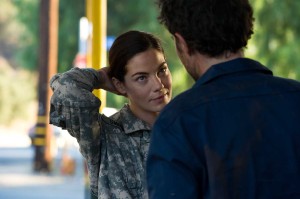 Meyers credits producer John Sullivan with bringing the film to the next level in the postproduction phase. Coming on during the production phase, Sullivan responded to the script and became very passionate about the material. He introduced her to Chesse, the King brothers and the composers. “I definitely credit him with helping build that incredible postproduction team,” said Meyers.
Meyers credits producer John Sullivan with bringing the film to the next level in the postproduction phase. Coming on during the production phase, Sullivan responded to the script and became very passionate about the material. He introduced her to Chesse, the King brothers and the composers. “I definitely credit him with helping build that incredible postproduction team,” said Meyers.
The crew mostly came from Los Angeles, with shooting occurring both in the Santa Clarita Valley of Southern California, and in and around Fort Bliss, Texas.
Public Affairs Officer, Major Joe Buccino, went “above-and-beyond” in coordinating logistical, location and technical support from the army. The military’s contributions allowed the filmmakers to achieve things that they would not otherwise been able to do on their budget. The only script changes suggested by the army had to do with technical issues. Nothing in the story was changed. The military just wanted to help the filmmakers do it right
“Even though the script delved into some complex and difficult issues, they felt that it was a story that needed to be told. It had the potential to raise awareness with the general public about some of the challenges that soldiers face when they return, particularly female veterans.” Meyers concluded, “They were a great partner for us.”





